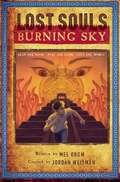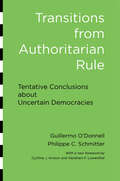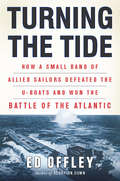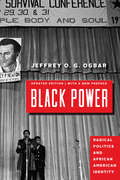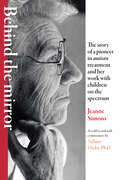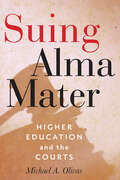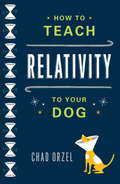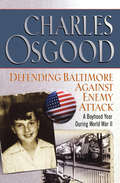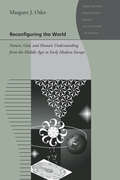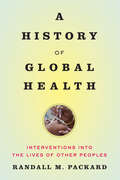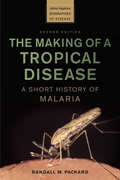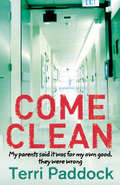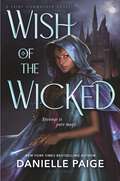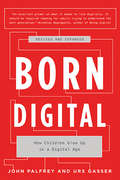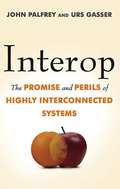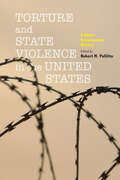- Table View
- List View
Lost Souls: Burning Sky
by Mel Odom Jordan WeismanIn this trilogy created by new media genius Jordan Weisman, the son of archeologists, Nathan is your typical kid--one of the smartest at his school, but fails at everything because he won't apply himself. Nathan is shocked when on his thirteenth birthday, he receives his birthright from the Mayan god Kukulkan: the ability to travel the frequencies and interact with spirits. The fate of the human race rests with Nathan, who must play a game with Kukulkan for the world's survival--all culminating with the end of the Mayan calendar on December 22, 2012. Now it is time for Nathan to use his newfound gifts, fulfill his potential, and save the world!
Transitions from Authoritarian Rule: Tentative Conclusions about Uncertain Democracies
by Guillermo O’Donnell Philippe C. Schmitter Laurence WhiteheadPolitical science scholars consider the four-volume work Transitions from Authoritarian Rule to be a foundational text for studying the process of democratization, specifically in those cases where an authoritarian regime is giving way to some form of democratic government. The most important of the four books is without a doubt the fourth volume, Tentative Conclusions about Uncertain Democracies, also known as "the little green book."Transitions from Authoritarian Rule was the first book in any language to systematically compare the process of transition from authoritarianism across a broad range of countries. Political democracy is not the only possible outcome. Guillermo O’Donnell, Philippe C. Schmitter, and Laurence Whitehead emphasize that it's not the revolution but the transition that is critical to the growth of a democratic state. This ground-breaking insight remains highly relevant as the ramifications of the Arab Spring continue to play out.This reissue features a new foreword by Cynthia J. Arnson, director of the Latin American Program at the Woodow Wilson International Center for Scholars, and Abraham F. Lowenthal, founding director of the Latin American Program, who wrote the original volume's foreword.
Deadly Choices: How the Anti-Vaccine Movement Threatens Us All
by Paul A. OffitLearn how we can prevent dangerous diseases -- and why some deadly epidemics are making a comeback -- in this guide to science, vaccines, and life-saving knowledge from a medical expert.In 2014, California suffered the largest and deadliest outbreak of pertussis, also known as "whooping cough," in more than fifty years.This tragedy was avoidable. An effective vaccine has been available since the 1940s. In recent years other diseases, like measles and mumps, have also made a comeback. The reason for these epidemics can be traced to a group whose vocal proponents insist, despite evidence to the contrary, that vaccines are poison. As a consequence, parents and caretakers are rejecting vaccines for themselves and their families.In Deadly Choices, infectious-disease expert Paul Offit takes a look behind the curtain of the anti-vaccine movement. What he finds is a reminder of the power of scientific knowledge, and the harm we risk if we ignore it.
Turning the Tide: How a Small Band of Allied Sailors Defeated the U-boats and Won the Battle of the Atlantic (Playaway Adult Nonfiction Ser.)
by Ed OffleyThe United States experienced its most harrowing military disaster of World War II not in 1941 at Pearl Harbor but in the period from 1942 to 1943, in Atlantic coastal waters from Newfoundland to the Caribbean. Sinking merchant ships with impunity, German U-boats threatened the lifeline between the United States and Britain, very nearly denying the Allies their springboard onto the European Continent--a loss that would have effectively cost the Allies the war.In Turning the Tide, author Ed Offley tells the gripping story of how, during a twelve-week period in the spring of 1943, a handful of battle-hardened American, British, and Canadian sailors turned the tide in the Atlantic. Using extensive archival research and interviews with key survivors, Offley places the reader at the heart of the most decisive maritime battle of World War II.
Black Power: Radical Politics and African American Identity
by Jeffrey O. G. OgbarOutstanding Academic Title, ChoiceIn the 1960s and 70s, the two most important black nationalist organizations, the Nation of Islam and the Black Panther Party, gave voice and agency to the most economically and politically isolated members of black communities outside the South. Though vilified as fringe and extremist, these movements proved to be formidable agents of influence during the civil rights era, ultimately giving birth to the Black Power movement.Drawing on deep archival research and interviews with key participants, Jeffrey O. G. Ogbar reconsiders the commingled stories of;¢;‚¬;€?and popular reactions to;¢;‚¬;€?the Nation of Islam, Black Panthers, and mainstream civil rights leaders. Ogbar finds that many African Americans embraced the seemingly contradictory political agenda of desegregation and nationalism. Indeed, black nationalism, he demonstrates, was far more favorably received among African Americans than historians have previously acknowledged. It engendered minority pride and influenced the political, cultural, and religious spheres of mainstream African American life for the decades to come.This updated edition of Ogbar's classic work contains a new preface that describes the book's genesis and links the Black Power movement to the Black Lives Matter movement. A thoroughly updated essay on sources contains a comprehensive review of Black Power;€“related scholarship. Ultimately, Black Power reveals a black freedom movement in which the ideals of desegregation through nonviolence and black nationalism marched side by side.
Black Power: Radical Politics and African American Identity
by Jeffrey O. G. OgbarOutstanding Academic Title, ChoiceIn the 1960s and 70s, the two most important black nationalist organizations, the Nation of Islam and the Black Panther Party, gave voice and agency to the most economically and politically isolated members of black communities outside the South. Though vilified as fringe and extremist, these movements proved to be formidable agents of influence during the civil rights era, ultimately giving birth to the Black Power movement.Drawing on deep archival research and interviews with key participants, Jeffrey O. G. Ogbar reconsiders the commingled stories of;¢;‚¬;€?and popular reactions to;¢;‚¬;€?the Nation of Islam, Black Panthers, and mainstream civil rights leaders. Ogbar finds that many African Americans embraced the seemingly contradictory political agenda of desegregation and nationalism. Indeed, black nationalism, he demonstrates, was far more favorably received among African Americans than historians have previously acknowledged. It engendered minority pride and influenced the political, cultural, and religious spheres of mainstream African American life for the decades to come.This updated edition of Ogbar's classic work contains a new preface that describes the book's genesis and links the Black Power movement to the Black Lives Matter movement. A thoroughly updated essay on sources contains a comprehensive review of Black Power;€“related scholarship. Ultimately, Black Power reveals a black freedom movement in which the ideals of desegregation through nonviolence and black nationalism marched side by side.
Behind the Mirror: The Story of a Pioneer in Autism Treatment and Her Work with Children on the Spectrum
by Sabine Oishi Jeanne SimonsThe life story of Jeanne Simons, whose own autism informed her pioneering work with autistic children.Jeanne Simons devoted her career as a social worker and educator to the study, treatment, and care of children with autism. In 1955, she established the Linwood Children's Center in Ellicott City, Maryland, one of the first schools dedicated to children with autism. Her Linwood Model, developed there, was widely adopted and still forms the basis for a variety of autism intervention techniques. Incredibly—although unknown at the time—Jeanne was herself autistic. Behind the Mirror reveals the remarkable tale of this trailblazer and how she thought, felt, and experienced the world around her. With moving immediacy, Jeanne tells her life story to developmental psychologist, friend, and collaborator Sabine Oishi. Jeanne's unique experience is supplemented by commentary from Dr. Oishi, who explains the importance of key biographical details and fills in additional information about the diagnosis and treatment of autism. Enhanced with a photo gallery, a look at new approaches to the education of children with autism, and a history of Linwood since its founding, the book also contains a foreword, an afterword, and an appendix by James C. Harris, MD, the past director of child psychiatry at Johns Hopkins University School of Medicine and the founder of its autism clinic. Demystifying the experience of autism, Behind the Mirror is a groundbreaking account of possibilities and hope.
Suing Alma Mater: Higher Education and the Courts
by Michael A. OlivasAlthough much has been written about U.S. Supreme Court decisions involving higher education, little has been said about the foundational case law and litigation patterns emerging from the lower courts. As universities become increasingly legislated, regulated, and litigious, campuses have become testing grounds for a host of constitutional challenges. From faculty and student free speech to race- or religion-based admissions policies, Suing Alma Mater describes the key issues at play in higher education law.Eminent legal scholar Michael A. Olivas considers higher education litigation in the latter half of the twentieth century and the rise of "purposive organizations," like the American Civil Liberties Union and the Alliance Defense Fund (now known as the Alliance Defending Freedom), that exist to advance litigation. He reviews more than 120 college cases brought before the Supreme Court in the past fifty years and then discusses six key cases in depth. Suing Alma Mater provides a clear-eyed perspective on the legal issues facing higher education today.
Suing Alma Mater: Higher Education and the Courts
by Michael A. OlivasAlthough much has been written about U.S. Supreme Court decisions involving higher education, little has been said about the foundational case law and litigation patterns emerging from the lower courts. As universities become increasingly legislated, regulated, and litigious, campuses have become testing grounds for a host of constitutional challenges. From faculty and student free speech to race- or religion-based admissions policies, Suing Alma Mater describes the key issues at play in higher education law.Eminent legal scholar Michael A. Olivas considers higher education litigation in the latter half of the twentieth century and the rise of "purposive organizations," like the American Civil Liberties Union and the Alliance Defense Fund (now known as the Alliance Defending Freedom), that exist to advance litigation. He reviews more than 120 college cases brought before the Supreme Court in the past fifty years and then discusses six key cases in depth. Suing Alma Mater provides a clear-eyed perspective on the legal issues facing higher education today.
Introductory Statistics
by OpenStaxIntroductory Statistics is intended for the one-semester introduction to statistics course for students who are not mathematics or engineering majors. It focuses on the interpretation of statistical results, especially in real world settings, and assumes that students have an understanding of intermediate algebra. In addition to end of section practice and homework sets, examples of each topic are explained step-by-step throughout the text and followed by a Try It problem that is designed as extra practice for students. This book also includes collaborative exercises and statistics labs designed to give students the opportunity to work together and explore key concepts. To support today's student in understanding technology, this book features TI 83, 83+, 84, or 84+ calculator instructions at strategic points throughout. While the book has been built so that each chapter builds on the previous, it can be rearranged to accommodate any instructor's particular needs.
How to Teach Relativity to Your Dog: Relativitätstheorie (nicht Nur) Für Vierbeiner
by Chad OrzelThey say you can't teach an old dog new tricks. But what about relativity?Physics professor Chad Orzel and his inquisitive canine companion, Emmy, tackle the concepts of general relativity in this irresistible introduction to Einstein's physics. Through armchair- and sometimes passenger-seat-conversations with Emmy about the relative speeds of dog and cat motion or the logistics of squirrel-chasing, Orzel translates complex Einsteinian ideas -- the slowing of time for a moving observer, the shrinking of moving objects, the effects of gravity on light and time, black holes, the Big Bang, and of course, E=mc2 -- into examples simple enough for a dog to understand. A lively romp through one of the great theories of modern physics, How to Teach Relativity to Your Dog will teach you everything you ever wanted to know about space, time, and anything else you might have slept through in high school physics class.
How to Teach Relativity to Your Dog
by Chad OrzelThey say you can't teach an old dog new tricks. But what about relativity? Physics professor Chad Orzel and his inquisitive canine companion, Emmy, tackle the concepts of general relativity in this irresistible introduction to Einstein's physics. Through armchair- and sometimes passenger-seat-conversations with Emmy about the relative speeds of dog and cat motion or the logistics of squirrel-chasing, Orzel translates complex Einsteinian ideas -- the slowing of time for a moving observer, the shrinking of moving objects, the effects of gravity on light and time, black holes, the Big Bang, and of course, E=mc2 -- into examples simple enough for a dog to understand. A lively romp through one of the great theories of modern physics, How to Teach Relativity to Your Dog will teach you everything you ever wanted to know about space, time, and anything else you might have slept through in high school physics class.
Defending Baltimore Against Enemy Attack: A Boyhood Year During World War II
by Charles OsgoodFrom beloved broadcaster Charles Osgood, a poignant memoir about one unforgettable childhood year during World War II. Defending Baltimore Against Enemy Attack is a gloriously funny and nostalgic slice of American life and a moving look at World War II from the perspective of a child far away from the fighting, but very conscious of the reverberations. With a sharp eye for details, Osgood captures the texture of life in a bygone era.
Defending Baltimore Against Enemy Attack: A Boyhood Year During World War II
by Charles OsgoodFrom beloved broadcaster Charles Osgood, a poignant memoir about one unforgettable childhood year during World War II.Defending Baltimore Against Enemy Attack is a gloriously funny and nostalgic slice of American life and a moving look at World War II from the perspective of a child far away from the fighting, but very conscious of the reverberations. With a sharp eye for details, Osgood captures the texture of life in a bygone era.
Reconfiguring the World: Nature, God, and Human Understanding from the Middle Ages to Early Modern Europe (Johns Hopkins Introductory Studies in the History of Science)
by Margaret J. OslerChange in human understanding of the natural world during the early modern period marks one of the most important episodes in intellectual history. This era is often referred to as the scientific revolution, but recent scholarship has challenged traditional accounts. Here, in Reconfiguring the World, Margaret J. Osler treats the development of the sciences in Europe from the early sixteenth to the late seventeenth centuries as a complex and multifaceted process.The worldview embedded in modern science is a relatively recent development. Osler aims to convey a nuanced understanding of how the natural world looked to early modern thinkers such as Galileo, Descartes, Boyle, and Newton. She describes investigation and understanding of the natural world in terms that the thinkers themselves would have used. Tracing the views of the natural world to their biblical, Greek, and Arabic sources, Osler demonstrates the impact of the Renaissance recovery of ancient texts, printing, the Protestant Reformation, and the exploration of the New World. She shows how the traditional disciplinary boundaries established by Aristotle changed dramatically during this period and finds the tensions of science and religion expressed as differences between natural philosophy and theology.Far from a triumphalist account, Osler’s story includes false starts and dead ends. Ultimately, she shows how a few gifted students of nature changed the way we see ourselves and the universe.
A History of Global Health: Interventions into the Lives of Other Peoples
by Randall M. PackardOver the past century, hundreds of billions of dollars have been invested in programs aimed at improving health on a global scale. Given the enormous scale and complexity of these lifesaving operations, why do millions of people in low-income countries continue to live without access to basic health services, sanitation, or clean water? And why are deadly diseases like Ebola able to spread so quickly among populations?In A History of Global Health, Randall M. Packard argues that global-health initiatives have saved millions of lives but have had limited impact on the overall health of people living in underdeveloped areas, where health-care workers are poorly paid, infrastructure and basic supplies such as disposable gloves, syringes, and bandages are lacking, and little effort has been made to address the underlying social and economic determinants of ill health. Global-health campaigns have relied on the application of biomedical technologies;¢;‚¬;€?vaccines, insecticide-treated nets, vitamin A capsules;¢;‚¬;€?to attack specific health problems but have failed to invest in building lasting infrastructure for managing the ongoing health problems of local populations.Designed to be read and taught, the book offers a critical historical view, providing historians, policy makers, researchers, program managers, and students with an essential new perspective on the formation and implementation of global-health policies and practices.
A History of Global Health: Interventions into the Lives of Other Peoples
by Randall M. PackardOver the past century, hundreds of billions of dollars have been invested in programs aimed at improving health on a global scale. Given the enormous scale and complexity of these lifesaving operations, why do millions of people in low-income countries continue to live without access to basic health services, sanitation, or clean water? And why are deadly diseases like Ebola able to spread so quickly among populations?In A History of Global Health, Randall M. Packard argues that global-health initiatives have saved millions of lives but have had limited impact on the overall health of people living in underdeveloped areas, where health-care workers are poorly paid, infrastructure and basic supplies such as disposable gloves, syringes, and bandages are lacking, and little effort has been made to address the underlying social and economic determinants of ill health. Global-health campaigns have relied on the application of biomedical technologies;¢;‚¬;€?vaccines, insecticide-treated nets, vitamin A capsules;¢;‚¬;€?to attack specific health problems but have failed to invest in building lasting infrastructure for managing the ongoing health problems of local populations.Designed to be read and taught, the book offers a critical historical view, providing historians, policy makers, researchers, program managers, and students with an essential new perspective on the formation and implementation of global-health policies and practices.
The Making of a Tropical Disease: A Short History of Malaria (Johns Hopkins Biographies of Disease)
by Randall M. PackardA global history of malaria that traces the natural and social forces that have shaped its spread and made it deadly, while limiting efforts to eliminate it.Malaria sickens hundreds of millions of people—and kills nearly a half a million—each year. Despite massive efforts to eradicate the disease, it remains a major public health problem in poorer tropical regions. But malaria has not always been concentrated in tropical areas. How did malaria disappear from other regions, and why does it persist in the tropics? From Russia to Bengal to Palm Beach, Randall M. Packard's far-ranging narrative shows how the history of malaria has been driven by the interplay of social, biological, economic, and environmental forces. The shifting alignment of these forces has largely determined the social and geographical distribution of the disease, including its initial global expansion, its subsequent retreat to the tropics, and its current persistence. Packard argues that efforts to control and eliminate malaria have often ignored this reality, relying on the use of biotechnologies to fight the disease. Failure to address the forces driving malaria transmission have undermined past control efforts.Describing major changes in both the epidemiology of malaria and efforts to control the disease, the revised edition of this acclaimed history, which was chosen as the 2008 End Malaria Awards Book of the Year in its original printing,• examines recent efforts to eradicate malaria following massive increases in funding and political commitment; • discusses the development of new malaria-fighting biotechnologies, including long-lasting insecticide-treated nets, rapid diagnostic tests, combination artemisinin therapies, and genetically modified mosquitoes; • explores the efficacy of newly developed vaccines; and • explains why eliminating malaria will also require addressing the social forces that drive the disease and building health infrastructures that can identify and treat the last cases of malaria.Authoritative, fascinating, and eye-opening, this short history of malaria concludes with policy recommendations for improving control strategies and saving lives.
The Making of a Tropical Disease: A Short History of Malaria (Johns Hopkins Biographies of Disease)
by Randall M. PackardA global history of malaria that traces the natural and social forces that have shaped its spread and made it deadly, while limiting efforts to eliminate it.Malaria sickens hundreds of millions of people—and kills nearly a half a million—each year. Despite massive efforts to eradicate the disease, it remains a major public health problem in poorer tropical regions. But malaria has not always been concentrated in tropical areas. How did malaria disappear from other regions, and why does it persist in the tropics? From Russia to Bengal to Palm Beach, Randall M. Packard's far-ranging narrative shows how the history of malaria has been driven by the interplay of social, biological, economic, and environmental forces. The shifting alignment of these forces has largely determined the social and geographical distribution of the disease, including its initial global expansion, its subsequent retreat to the tropics, and its current persistence. Packard argues that efforts to control and eliminate malaria have often ignored this reality, relying on the use of biotechnologies to fight the disease. Failure to address the forces driving malaria transmission have undermined past control efforts.Describing major changes in both the epidemiology of malaria and efforts to control the disease, the revised edition of this acclaimed history, which was chosen as the 2008 End Malaria Awards Book of the Year in its original printing,• examines recent efforts to eradicate malaria following massive increases in funding and political commitment; • discusses the development of new malaria-fighting biotechnologies, including long-lasting insecticide-treated nets, rapid diagnostic tests, combination artemisinin therapies, and genetically modified mosquitoes; • explores the efficacy of newly developed vaccines; and • explains why eliminating malaria will also require addressing the social forces that drive the disease and building health infrastructures that can identify and treat the last cases of malaria.Authoritative, fascinating, and eye-opening, this short history of malaria concludes with policy recommendations for improving control strategies and saving lives.
Come Clean
by Terri PaddockMesmerising, moving novel from an exceptional author about one girl’s struggle to cope after being wrongly admitted to a boot-camp-style rehabilitation centre. A powerful and page-turning read.
Wish of the Wicked (A Fairy Godmother Novel)
by Danielle PaigeNew York Times bestselling author Danielle Paige puts a dark YA spin on Cinderella's fairy godmother in this brand new origin story, perfect for fans of These Violent Delights and A Curse So Dark and Deadly.Everyone knows a fairy godmother helped Cinderella get to the ball. But no one knows why. For centuries, Farrow's family-the Entente-have been magical advisors to the Queen. Their wisdom and foresight kept the Thirteen Queendoms in harmony. Until a new queen, Magrit, takes power, outlaws magic, and executes the Entente. Only Farrow survives, with her magic warped beyond repair. She can now use it only to fulfill the feeble wishes of commoners.Since that day, Farrow has dreamed of revenge. The one way to reach the queen is through her son, Prince Mather, who is nearing the age when he must select a bride. When a special ball in his honor is announced, Farrow sees her opportunity. All it will take is a young woman named Cinderella who dreams of true love. With one night, one chance to reclaim her magic and destroy the queen, Farrow will stop at nothing.Set in a lush, dangerous world rooted in our beloved fairy tales, New York Times bestselling author Danielle Paige launches a brand-new Fairy Godmother origin story full of intrigue, magic, and romance.
Born Digital: How Children Grow Up in a Digital Age
by John Palfrey Urs Gasser"An excellent primer on what it means to live digitally. It should be required reading for adults trying to understand the next generation." --Nicholas Negroponte, author of Being DigitalThe first generation of children who were born into and raised in the digital world are coming of age and reshaping the world in their image. Our economy, our politics, our culture, and even the shape of our family life are being transformed. But who are these wired young people? And what is the world they're creating going to look like? In this revised and updated edition, leading Internet and technology experts John Palfrey and Urs Gasser offer a cutting-edge sociological portrait of these young people, who can seem, even to those merely a generation older, both extraordinarily sophisticated and strangely narrow. Exploring a broad range of issues--privacy concerns, the psychological effects of information overload, and larger ethical issues raised by the fact that young people's social interactions, friendships, and civic activities are now mediated by digital technologies--Born Digital is essential reading for parents, teachers, and the myriad of confused adults who want to understand the digital present and shape the digital future.
Interop: The Promise and Perils of Highly Interconnected Systems
by John Palfrey Urs GasserIn Interop, technology experts John Palfrey and Urs Gasser explore the immense importance of interoperability-the standardization and integration of technology-and show how this simple principle will hold the key to our success in the coming decades and beyond.The practice of standardization has been facilitating innovation and economic growth for centuries. The standardization of the railroad gauge revolutionized the flow of commodities, the standardization of money revolutionized debt markets and simplified trade, and the standardization of credit networks has allowed for the purchase of goods using money deposited in a bank half a world away. These advancements did not eradicate the different systems they affected; instead, each system has been transformed so that it can interoperate with systems all over the world, while still preserving local diversity.As Palfrey and Gasser show, interoperability is a critical aspect of any successful system-and now it is more important than ever. Today we are confronted with challenges that affect us on a global scale: the financial crisis, the quest for sustainable energy, and the need to reform health care systems and improve global disaster response systems. The successful flow of information across systems is crucial if we are to solve these problems, but we must also learn to manage the vast degree of interconnection inherent in each system involved. Interoperability offers a number of solutions to these global challenges, but Palfrey and Gasser also consider its potential negative effects, especially with respect to privacy, security, and co-dependence of states; indeed, interoperability has already sparked debates about document data formats, digital music, and how to create successful yet safe cloud computing. Interop demonstrates that, in order to get the most out of interoperability while minimizing its risks, we will need to fundamentally revisit our understanding of how it works, and how it can allow for improvements in each of its constituent parts.In Interop, Palfrey and Gasser argue that there needs to be a nuanced, stable theory of interoperability-one that still generates efficiencies, but which also ensures a sustainable mode of interconnection. Pointing the way forward for the new information economy, Interop provides valuable insights into how technological integration and innovation can flourish in the twenty-first century.
Torture and State Violence in the United States: A Short Documentary History
by Robert M. PallittoThe war on terror has brought to light troubling actions by the United States government which many claim amount to torture. But as this book shows, state-sanctioned violence and degrading, cruel, and unusual punishments have a long and contentious history in the nation. Organized around five broad thematic periods in American history—colonial America and the early republic; slavery and the frontier; imperialism, Jim Crow, and World Wars I and II; the Cold War, Vietnam, and police torture; and the war on terror—this annotated documentary history traces the low and high points of official attitudes toward state violence. Robert M. Pallitto provides a critical introduction, historical context, and brief commentary and then lets the documents speak for themselves. The result is a nearly 400-year history that traces the continuities and changes in debates over the meaning of torture and state violence in the U.S. and shows where state actions and policies have pushed and exceeded constitutional and international normative limits. Rigorously researched—and sometimes chilling—this volume is the first comprehensive reference work on state violence and torture in the U.S.
Torture and State Violence in the United States: A Short Documentary History
by Robert M. PallittoThe war on terror has brought to light troubling actions by the United States government which many claim amount to torture. But as this book shows, state-sanctioned violence and degrading, cruel, and unusual punishments have a long and contentious history in the nation. Organized around five broad thematic periods in American history—colonial America and the early republic; slavery and the frontier; imperialism, Jim Crow, and World Wars I and II; the Cold War, Vietnam, and police torture; and the war on terror—this annotated documentary history traces the low and high points of official attitudes toward state violence. Robert M. Pallitto provides a critical introduction, historical context, and brief commentary and then lets the documents speak for themselves. The result is a nearly 400-year history that traces the continuities and changes in debates over the meaning of torture and state violence in the U.S. and shows where state actions and policies have pushed and exceeded constitutional and international normative limits. Rigorously researched—and sometimes chilling—this volume is the first comprehensive reference work on state violence and torture in the U.S.
